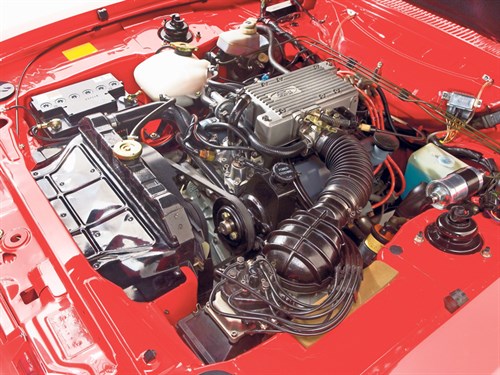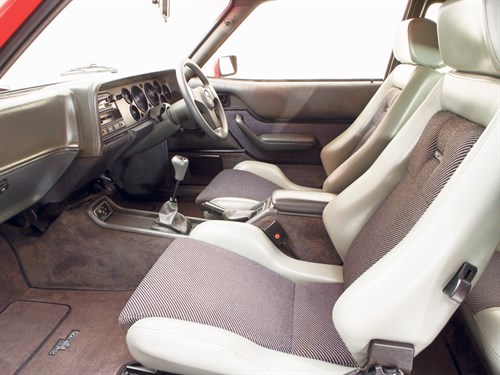Kept in production purely for British consumption...

The 2.8i featured numerous improvements over standard MkIII Capris including halogen headlamps, pepperpot alloys and a five-speed gearbox, with later 2.8i Special models gaining a colour-coded front grille, half-leather interior, limited slip differential and seven spoke RS wheels. Despite enthusiastic reviews by the motoring press, the Capri 2.8i failed to halt a steady downturn in sales, and, along with the 2.8i Special and 280 ‘Brooklands’, would be the last Capri model on sale, production winding up in 1986.
VITAL STATISTICS
Ford Capri 2.8i
Engine 2792cc/6-cyl/OHV
Power (bhp@rpm) 160bhp@5700rpm
Torque (lb ft@rpm) 162ft lb@4200rpm
Top speed 127mph
0-60mph 7.9sec
Consumption 27mpg
Gearbox 4 & 5-speed manual
WHAT TO LOOK FOR
BODYWORK & CHASSIS
Capris will rust pretty much anywhere, so it’s important you check as much of the car as humanly possible. Don’t just look for rust, but also for filler and signs of bodged repair work. Many Capris ended up in the wars, so you’ll need to be vigilant of poorly repaired crash damage, especially to the chassis. A magnet is a useful tool to take when viewing any potential purpose. Sills and arches should be the first place to check for rust.
Don’t be afraid to get your hands dirty; feel along the back of the sills as high up as you can get. Repeat the procedure with the arches. Rust is often worse where you can’t see, so beware any cars that have corrosion underneath. The seams between the front wings and inner wings are also prone to corrosion, so it’s worth checking with the owner to see if the wings have been replaced at any point.
Scuttles are prone to rusting in cars that haven’t been garaged, so lift the bonnet and inspect where the windscreen meets the bodywork.
ENGINE
The 2.8-litre Cologne V6 is a robust unit, but as with any engine will suffer from the lack of proper maintenance. Regular oil changes are vital, so check that these have been carried out at the recommended intervals. Tuning options are fairly limited with the engine only responding well to forced induction, so most Capri 2.8is should be near enough as they left the factory. These engines are known to run quite hot, so it’s especially important to make sure it doesn’t overheat. Allow the car to heat up fully and check that the fan kicks in. Keep an eye on the temperature gauge – normal operating temperature will see the needle sit about halfway round the dial, but it can creep as far up as three quarters. As long as the fan prevents it going further then it should be fine.
Head gaskets have been known to let go after about 100,000 miles, so check the service history to see if it’s still running on its original part. Make sure there is no mayonnaise under the oil filler cap.

RUNNING GEAR
X-reg and early Y-reg cars were fitted with four-speed manual gearboxes, but later cars benefited from a five-speed unit. Vague gear selection is a common problem caused by wear to linkage bushes. It’s a relatively easy fix so don’t be overly concerned. A loud transmission that jumps out of gear is of more concern, and will mean that the gearbox is in need of an expensive rebuild. Synchromesh will wear with hard use, especially on second gear.
Ordinary 2.8i models were fitted with open differentials, while 2.8i Specials and 280 models were upgraded to limited slip differentials (LSD). Despite this, many Specials have had their LSDs cannibalised for other fast Ford projects, mostly ending up in MkI Escorts. You need to check that an LSD is really fitted, especially at the lower end of the market. Jack the rear of the car up and turn one of the rear wheels. If the other wheel turns the opposite direction, then a normal open diff is fitted. If they turn the same direction then it is likely to be an LSD. But all may not be as it seems – welded open diffs will turn the same way. To tell the difference, lower the other wheel to the ground. If the free wheel still turns then an LSD is fitted, if not it’s welded, and you should steer well clear.
INTERIOR
Early cars will be fitted with checked ‘Carla’ trim, with post April ‘83 cars equipped with Shark Grey cloth interior. 2.8i Specials were fitted with half-leather interior, which is more hardwearing than cloth. Pay particular attention to the driver’s seat bolster, making sure that any wear tallies with the displayed mileage. Dashboards can crack if exposed to heat for extended periods; check too for any stick-on replacements covers. Check that the heater blows hot and all the fan settings work. Replacement requires removal of the entire dashboard.

OUR VERDICT
Bar the top of the range 280 ‘Brooklands’, the 2.8-litre injection and 2.8i Special Capris are the ones to have. Though the 2.8i has less torque than the 3-litre Essex engine, it requires less maintenance and is more fuel efficient – perfect if you need reliable transport and not just a show queen. 160bhp may not seem a lot, but like so many cars, it’s the way the power is delivered that makes it such a hoot to drive. It has a reputation for being tail-happy, but to be honest, this is largely unfounded.